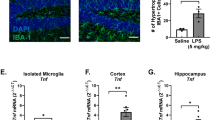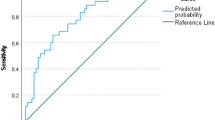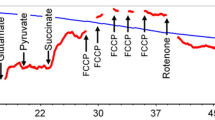Abstract
Impairments in mood and cognitive function are the key brain abnormalities observed in Gulf war illness (GWI), a chronic multisymptom health problem afflicting ∼25% of veterans who served in the Persian Gulf War-1. Although the precise cause of GWI is still unknown, combined exposure to a nerve gas prophylaxis drug pyridostigmine bromide (PB) and pesticides DEET and permethrin during the war has been proposed as one of the foremost causes of GWI. We investigated the effect of 4 weeks of exposure to Gulf war illness-related (GWIR) chemicals in the absence or presence of mild stress on mood and cognitive function, dentate gyrus neurogenesis, and neurons, microglia, and astrocytes in the hippocampus. Combined exposure to low doses of GWIR chemicals PB, DEET, and permethrin induced depressive- and anxiety-like behavior and spatial learning and memory dysfunction. Application of mild stress in the period of exposure to chemicals exacerbated the extent of mood and cognitive dysfunction. Furthermore, these behavioral impairments were associated with reduced hippocampal volume and multiple cellular alterations such as chronic reductions in neural stem cell activity and neurogenesis, partial loss of principal neurons, and mild inflammation comprising sporadic occurrence of activated microglia and significant hypertrophy of astrocytes. The results show the first evidence of an association between mood and cognitive dysfunction and hippocampal pathology epitomized by decreased neurogenesis, partial loss of principal neurons, and mild inflammation in a model of GWI. Hence, treatment strategies that are efficacious for enhancing neurogenesis and suppressing inflammation may be helpful for alleviation of mood and cognitive dysfunction observed in GWI.
Similar content being viewed by others
Log in or create a free account to read this content
Gain free access to this article, as well as selected content from this journal and more on nature.com
or
References
Abdel-Rahman A, Shetty AK, Abou-Donia MB (2002). Disruption of the blood-brain barrier and neuronal cell death in cingulate cortex, dentate gyrus, thalamus, and hypothalamus in a rat model of Gulf-War syndrome. Neurobiol Dis 10: 306–326.
Abdel-Rahman A, Abou-Donia S, El-Masry E, Shetty A, Abou-Donia M (2004a). Stress and combined exposure to low doses of PB, DEET, and permethrin produce neurochemical and neuropathological alterations in cerebral cortex, hippocampus, and cerebellum. J Toxicol Environ Health A 67: 163–192.
Abdel-Rahman A, Rao MS, Shetty AK (2004b). Nestin expression in hippocampal astrocytes after injury depends on the age. Glia 47: 299–313.
Abdullah L, Crynen G, Reed J, Bishop A, Phillips J, Ferguson S et al (2011). Proteomic CNS profile of delayed cognitive impairment in mice exposed to Gulf War agents. Neuromolecular Med 13: 275–288.
Abdullah L, Evans JE, Bishop A, Reed JM, Crynen G, Phillips J et al (2012). Lipidomic profiling of phosphocholine containing brain lipids in mice with sensorimotor deficits and anxiety-like features after exposure to gulf war agents. Neuromolecular Med 14: 349–361.
Abu-Qare W, Suliman HB, Abou-Donia MB (2001). Induction of urinary excretion of 3-nitrotyrosine, a marker of oxidative stress, following administration of pyridostigmine bromide, DEET (N,N-diethyl-m-toluamide) and permethrin, alone and in combination in rats. Toxicol Lett 121: 127–134.
Amato AA, McVey A, Cha C, Matthews EC, Jackson CE, Kleingunther R et al (1997). Evaluation of neuromuscular symptoms in veterans of the Persian Gulf War. Neurology 48: 4–12.
Apfel BA, Ross J, Hlavin J, Meyerhoff DJ, Metzler TJ, Marmar CR et al (2011). Hippocampal volume differences in Gulf War veterans with current versus lifetime posttraumatic stress disorder symptoms. Biol Psychiatry 69: 541–548.
Bilbo SD, Smith SH, Schwarz JM (2012). A lifespan approach to neuroinflammatory and cognitive disorders: a critical role of glia. J Neuroimmune Pharmacol 7: 24–41.
Binns JH, Barlow C, Bloom FE, Clauw DJ, Golomb BA, Graves JC et al (2008) Gulf war illness and the health of Gulf war veterans: scientific findings and recommendations, Research Advisory Committee Report on Gulf War Illness and Health of Gulf War Veterans. Dept of Veterans Affairs. US Government Printing Office: Washington, DC, pp 1–465.
Bizon JL, Lee HJ, Gallagher M (2004). Neurogenesis in a rat model of age-related cognitive decline. Aging Cell 3: 227–234.
Black DW, Carney CP, Peloso PM, Woolson RF, Schwartz DA, Voelker MD, Barrett DH, Doebbeling BN (2004). Gulf War veterans with anxiety: prevalence, co-morbidity, and risk factors. Epidemiology 15: 135–142.
Broadbent NJ, Gaskin S, Squire LR, Clark RE (2009). Object recognition memory and the rodent hippocampus. Learn Mem 17: 5–11.
Chaney LA, Wineman RW, Rockhold RW, Hume AS (2000). Acute effects of an insect repellent, N,N-diethyl-m-toluamide, on cholinesterase inhibition induced by pyridostigmine bromide in rats. Toxicol Appl Pharmacol 165: 107–114.
Corbel V, Stankiewicz M, Pennetier C, Fournier D, Stojan J, Girard E et al (2009). Evidence for inhibition of cholinesterases in insect and mammalian nervous systems by the insect repellent DEET. BMC Biol 7: 47.
David AS, Farrin L, Hull L, Unwin C, Wessely S, Wykes T (2002). Cognitive functioning and disturbances of mood in UK veterans of the Persian Gulf War: a comparative study. Psychol Med 32: 1357–1370.
David DJ, Samuels BA, Rainer Q, Wang JW, Marsteller D, Mendez I et al (2009). Neurogenesis-dependent and-independent effects of fluoxetine in an animal model of anxiety/depression. Neuron 62: 479–493.
Deng W, Aimone JB, Gage FH (2010). New neurons and new memories: how does adult hippocampal neurogenesis affect learning and memory? Nat Rev Neurosci 11: 339–350.
Drapeau E, Mayo W, Aurousseau C, Le Moal M, Piazza PV, Abrous DN (2003). Spatial memory performances of aged rats in the water maze predict levels of hippocampal neurogenesis. Proc Natl Acad Sci USA 100: 14385–14390.
Dupret D, Fabre A, Döbrössy MD, Panatier A, Rodríguez JJ, Lamarque S et al (2007). Spatial learning depends on both the addition and removal of new hippocampal neurons. PLoS Biol 5: e214.
Dupret D, Revest JM, Koehl M, Ichas F, De Giorgi F, Costet P et al (2008). Spatial relational memory requires hippocampal adult neurogenesis. PLoS One 3: e1959.
Eisch AJ, Petrik D (2012). Depression and hippocampal neurogenesis: a road to remission? Science 338: 72–75.
Everson MP, Kotler S, Blackburn WD (1999). Stress and immune dysfunction in Gulf War veterans. Ann NY Acad Sci 876: 413–418.
Fotuhi M, Do D, Jack C (2012). Modifiable factors that alter the size of the hippocampus with ageing. Nat Rev Neurol 8: 189–202.
Friedman A, Kaufer D, Shemer J, Hendler I, Soreq H, Tur-Kaspa I (1996). Pyridostigmine brain penetration under stress enhances neuronal excitability and induces early immediate transcriptional response. Nat Med 2: 1382–1385.
Golomb BA (2008). Acetylcholinesterase inhibitors and Gulf War illnesses. Proc Natl Sci Acad Sci USA 105: 4295–4300.
Haley RW, Kurt TL (1997). Self-reported exposure to neurotoxic chemical combinations in the Gulf war: a cross-sectional epidemiologic study. JAMA 277: 231–237.
Haley RW, Hom J, Roland PS, Bryan WW, Van Ness PC, Bonte FJ et al (1997). Evaluation of neurologic function in Gulf War veterans: a blinded case-control study. JAMA 277: 223–230.
Haley RW, Fleckenstein JL, Marshall WW, McDonald GG, Kramer GL, Petty F (2000a). Effect of basal ganglia injury on central dopamine activity in Gulf War syndrome: correlation of proton magnetic resonance spectroscopy and plasma homovanillic acid levels. Arch Neurol 57: 1280–1285.
Haley RW, Marshall WW, McDonald GG, Daugherty MA, Petty F, Fleckenstein JL (2000b). Brain abnormalities in Gulf War syndrome: evaluation with 1H MR spectroscopy. Radiology 215: 807–817.
Hattiangady B, Rao MS, Shetty AK (2004). Chronic temporal lobe epilepsy is associated with severely declined dentate neurogenesis in the adult hippocampus. Neurobiol Dis 17: 473–490.
Hattiangady B, Shetty AK (2008). Aging does not alter the number or phenotype of putative stem/progenitor cells in the neurogenic region of the hippocampus. Neurobiol Aging 29: 129–147.
Hattiangady B, Shetty AK (2010). Decreased neuronal differentiation of newly generated cells underlies diminished neurogenesis in chronic temporal lobe epilepsy. Hippocampus 20: 97–112.
Hattiangady B, Shetty AK (2012). Neural stem cell grafting counteracts hippocampal injury-mediated impairments in mood, memory, and neurogenesis. Stem Cells Transl Med 1: 696–708.
Herrero AI, Sandi C, Venero C (2006). Individual differences in anxiety trait are related to spatial learning abilities and hippocampal expression of mineralocorticoid receptors. Neurobiol Learn Mem 86: 150–159.
Hyams KC, Wignall FS, Roswell R (1996). War syndromes and their evaluation: from the US Civil War to the Persian Gulf War. Ann Intern Med 125: 398–405.
Kempermann G, Gast D, Gage FH (2002). Neuroplasticity in old age: sustained fivefold induction of hippocampal neurogenesis by long-term environmental enrichment. Ann Neurol 52: 135–143.
Kheirbek MA, Klemenhagen KC, Sahay A, Hen R (2012). Neurogenesis and generalization: a new approach to stratify and treat anxiety disorders. Nat Neurosci 15: 1613–1620.
Kohman RA, Rhodes JS (2013). Neurogenesis, inflammation and behavior. Brain Behav Immun 27: 22–32.
Krishnadas R, Cavanagh J (2012). Depression: an inflammatory illness? Neurol Neurosurg Psychiatry 83: 495–502.
Li L, Shou Y, Borowitz JL, Isom GE (2001). Reactive oxygen species mediate pyridostigmine-induced neuronal apoptosis: involvement of muscarinic and NMDA receptors. Toxicol Appl Pharmacol 177: 17–25.
Li X, Spence JS, Buhner DM, Hart J Jr, Cullum CM, Biggs MM, Hester AL, Odegard TN, Carmack PS, Briggs RW, Haley RW (2011). Hippocampal dysfunction in Gulf war veterans: investigation with ASL perfusion MR imaging and physostigmine challenge. Radiology 261: 218–225.
Malberg JE, Eisch AJ, Nestler EJ, Duman RS (2000). Chronic antidepressant treatment increases neurogenesis in adult rat hippocampus. J Neurosci 20: 9104–9110.
Manganas LN, Zhang X, Li Y, Hazel RD, Smith SD, Wagshul ME et al (2007). Magnetic resonance spectroscopy identifies neural progenitor cells in the live human brain. Science 318: 980–985.
Menon PM, Nasrallah HA, Reeves RR, Ali JA (2004). Hippocampal dysfunction in Gulf War Syndrome. A proton MR spectroscopy study. Brain Res 1009: 189–194.
Meshi D, Drew MR, Saxe M, Ansorge MS, David D, Santarelli L et al (2006). Hippocampal neurogenesis is not required for behavioral effects of environmental enrichment. Nat Neurosci 9: 729–731.
Montaron MF, Drapeau E, Dupret D, Kitchener P, Aurousseau C, Le Moal M et al (2006). Lifelong corticosterone level determines age-related decline in neurogenesis and memory. Neurobiol Aging 27: 645–654.
Narahashi T (1985). Nerve membrane ionic channels as the primary target of pyrethroids. Neurotoxicol 6: 3–22.
Odegard TN, Cooper CM, Farris EA, Arduengo J, Bartlett J, Haley R (2012). Memory impairment exhibited by veterans with Gulf war illness. Neurocase, 23 April 2013 (e-pub ahead of print).
Parihar VK, Hattiangady B, Kuruba R, Shuai B, Shetty AK (2011). Predictable chronic mild stress improves mood, hippocampal neurogenesis and memory. Mol Psychiatry 16: 171–183.
Pereira AC, Huddleston DE, Brickman AM, Sosunov AA, Hen R, McKhann GM et al (2007). An in vivo correlate of exercise-induced neurogenesis in the adult dentate gyrus. Proc Natl Acad Sci USA 104: 5638–5643.
Perera TD, Dwork AJ, Keegan KA, Thirumangalakudi L, Lipira CM, Joyce N et al (2011). Necessity of hippocampal neurogenesis for the therapeutic action of antidepressants in adult nonhuman primates. PLoS One 6: e17600.
Ray DE, Fry JR (2006). A reassessment of the neurotoxicity of pyrethroid insecticides. Pharmacol Ther 111: 174–193.
Santarelli L, Saxe M, Gross C, Surget A, Battaglia F, Dulawa S et al (2003). Requirement of hippocampal neurogenesis for the behavioral effects of antidepressants. Science 301: 805–809.
Shetty AK, Hattiangady B, Rao MS (2009). Vulnerability of hippocampal GABA-ergic interneurons to kainate induced excitotoxic injury during old age. J Cell Mol Med 13: 2408–2423.
Shetty AK, Rao MS, Hattiangady B, Zaman V, Shetty GA (2004). Hippocampal neurotrophin levels after injury: Relationship to the age of the hippocampus at the time of injury. J Neurosci Res 78: 520–532.
Small SA, Schobel SA, Buxton RB, Witter MP, Barnes CA (2011). A pathophysiological framework of hippocampal dysfunction in ageing and disease. Nat Rev Neurosci 12: 585–601.
Snyder JS, Soumier AM, Brewer M, Pickel J, Cameron HA (2011). Adult hippocampal neurogenesis buffers stress responses and depressive behavior. Nature 476: 458–461.
Steele L (2000). Prevalence and patterns of Gulf war illness in Kansas veterans: association of symptoms with characteristics of person, place, time of military service. Am J Epidemiol 152: 992–1002.
Steele L, Sastre A, Gerkovich MM, Cook MR (2012). Complex factors in the etiology of Gulf War illness: wartime exposures and risk factors in veteran subgroups. Environ Health Perspect 120: 112–118.
Torres-Altoro MI, Mathur BN, Drerup JM, Thomas R, Lovinger DM, O'Callaghan JP et al (2011). Organophosphates dysregulate dopamine signaling, glutamatergic neurotransmission, and induce neuronal injury markers in striatum. J Neurochem 119: 303–313.
Treit D, Fundytus M (1998). Thigmotaxis as a test for anxiolytic activity in rats. Pharmacol Biochem Behav 31: 959–962.
van Praag H, Shubert T, Zhao C, Gage FH (2005). Exercise enhances learning and hippocampal neurogenesis in aged mice. J Neurosci 25: 8680–8685.
Veltri JC, Osimitz TG, Bradford DC, Page BC (1994). Retrospective analysis of calls to poison control centers resulting from exposure to the insect repellent N,N-diethyl-m-toluamide (DEET) from 1985-1989. J Toxicol Clin Toxicol 32: 1–16.
Vijverberg HP, van den Bercken J (1990). Neurotoxicological effects and the mode of action of pyrethroid insecticides. Crit Rev Toxicol 21: 105–126.
Vythilingam M, Luckenbaugh DA, Lam T, Morgan CA, Lipschitz D, Charney DS et al (2005). Smaller head of the hippocampus in Gulf War-related posttraumatic stress disorder. Psychiatry Res 139: 89–99.
Wang J, Gallagher D, DeVito LM, Cancino GI, Tsui D, He L et al (2012). Metformin activates an atypical PKC-CBP pathway to promote neurogenesis and enhance spatial memory formation. Cell Stem Cell 11: 23–35.
Acknowledgements
This study was supported primarily by a grant for ‘Gulf War Illness Research’ from the Department of Veterans Affairs (Merit Review Award to AKS) and partly by a grant from the Texas A&M Health Science Center (Emerging Technology Funds to AKS).
Author information
Authors and Affiliations
Corresponding author
Additional information
Author contributions
VKP, BH, and AKS contributed equally to this work. VKP performed chemical and stress exposures to animals, behavioral experiments, immunohistochemistry, stereological cell counts, collection, analyses, and interpretation of data and prepared an initial rough draft of the manuscript text. BH gave input to behavioral experiments, performed immunohistochemistry, stereological cell counts, confocal microscopy, and contributed to collection, analyses, and interpretation of behavioral data and assembly of figures. BS performed chemical and stress exposures to animals, tissue processing, histology, immunohistochemistry, and contributed to behavioral experiments and collection of data. AKS conceived the study, conceptualized the experimental design, analyzed, interpreted and assembled data, prepared all figures and wrote the manuscript. All authors gave input to the manuscript text and approved the final version of the manuscript.
Supplementary Information accompanies the paper on the Neuropsychopharmacology website
Supplementary information
Rights and permissions
About this article
Cite this article
Parihar, V., Hattiangady, B., Shuai, B. et al. Mood and Memory Deficits in a Model of Gulf War Illness Are Linked with Reduced Neurogenesis, Partial Neuron Loss, and Mild Inflammation in the Hippocampus. Neuropsychopharmacol 38, 2348–2362 (2013). https://doi.org/10.1038/npp.2013.158
Received:
Revised:
Accepted:
Published:
Issue date:
DOI: https://doi.org/10.1038/npp.2013.158
Keywords
This article is cited by
-
Pathophysiological basis and promise of experimental therapies for Gulf War Illness, a chronic neuropsychiatric syndrome in veterans
Psychopharmacology (2023)
-
Impact of gulf war toxic exposures after mild traumatic brain injury
Acta Neuropathologica Communications (2022)
-
Anxiety-like behavior and microglial activation in the amygdala after acute neuroinflammation induced by microbial neuraminidase
Scientific Reports (2022)
-
Circulating HMGB1 is elevated in veterans with Gulf War Illness and triggers the persistent pro-inflammatory microglia phenotype in male C57Bl/6J mice
Translational Psychiatry (2021)
-
Restorative potential of (−)-epicatechin in a rat model of Gulf War illness muscle atrophy and fatigue
Scientific Reports (2021)



